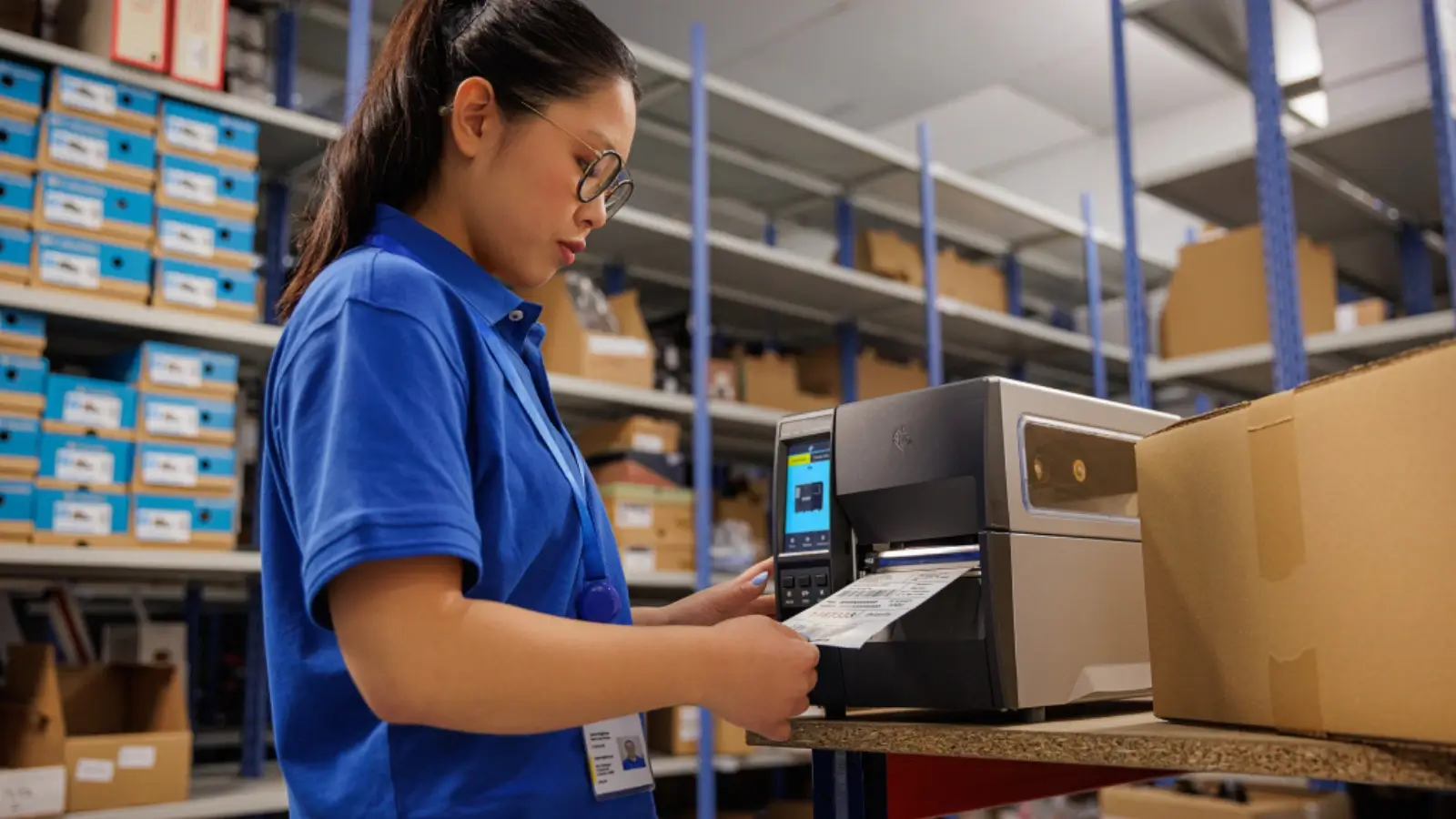


Choosing the right industrial label printer for your business is an important decision that can affect efficiency, compliance, and overall workflow. From tracking inventory to labeling products for shipping or safety, your printer is more than just a peripheral device—it’s a vital part of your production process. The wrong choice could lead to wasted time, costly errors, or compliance issues, while the right one can streamline operations and save money in the long run.
An industrial label printer is designed to produce high volumes of durable labels for demanding environments such as manufacturing plants, warehouses, or distribution centers. Unlike desktop or consumer-grade printers, these machines are built for continuous operation, high-speed output, and long-lasting performance. They can handle tough materials and print in conditions that would damage ordinary printers.
Industrial label printers are used for a wide range of applications, including barcode labels, asset tags, product identification, and safety signage. Because they integrate easily with business systems and labeling software, they are essential for maintaining traceability and organization in industries like logistics, pharmaceuticals, food and beverage, and electronics manufacturing.
Before choosing an industrial label printer, start by evaluating your business’s labeling requirements. Consider factors such as:
Label volume: How many labels do you print per day or per week? High-volume operations need printers capable of running continuously without overheating.
Label size and type: Determine the dimensions, shapes, and materials you’ll use. Some printers handle specialized media like heat-resistant, chemical-resistant, or weatherproof labels.
Print durability: If your labels are exposed to harsh conditions—such as moisture, extreme temperatures, or chemicals—you’ll need a printer that supports durable materials and permanent inks.
Print speed: Fast-paced operations require a printer that can keep up without sacrificing quality.
Connectivity: Think about how your printer will integrate with your existing systems. Options include USB, Ethernet, Wi-Fi, and Bluetooth connections.
Understanding these needs ensures that your investment aligns with your operational goals and prevents unnecessary downtime.
Not all industrial label printers are the same. The right model depends on your workflow, materials, and environment. Here are the most common types:
Thermal transfer printers use a ribbon coated with wax, resin, or a combination of both. Heat transfers the ink from the ribbon onto the label material, producing highly durable prints. These labels resist fading, smudging, and abrasion, making them ideal for outdoor use or industrial applications.
If you’re printing barcodes, chemical container labels, or asset tags that must last for years, a thermal transfer industrial label printer is an excellent choice.
Direct thermal printers don’t use ribbons. Instead, they print directly onto heat-sensitive labels. While they’re cost-effective and easy to maintain, the printed labels are not as durable. Exposure to heat, light, or friction can cause fading.
These printers are ideal for temporary labeling tasks such as shipping, inventory, or logistics applications where labels are used for a short time.
While less common in industrial settings, inkjet and laser label printers are used for high-resolution color labels. If you produce custom packaging, branding materials, or labels with complex graphics, these options can provide professional results.
However, they generally require more maintenance and have higher ink or toner costs, so they’re better suited for specialized printing rather than high-volume production.
Print resolution determines how sharp and readable your labels will be. For basic text or barcodes, a resolution of 203 dpi (dots per inch) may suffice. However, if you’re printing small fonts, detailed graphics, or QR codes, a higher resolution—300 dpi or 600 dpi—will provide crisper results.
High-resolution printing is particularly important for industries that must meet strict labeling regulations, such as pharmaceuticals or electronics. Poor-quality labels can lead to scanning errors or compliance violations, both of which can be costly.
Because industrial label printers operate in demanding environments, build quality matters. Look for printers with metal frames or reinforced housings that can withstand vibration, dust, and temperature fluctuations. Some models even include dust-resistant or waterproof enclosures.
A rugged printer minimizes downtime due to breakdowns and reduces long-term maintenance costs. Investing in a reliable industrial label printer up front will often save more money than replacing cheaper models that fail prematurely.
Your printer should handle a wide range of label materials and sizes. Check compatibility with different substrates such as paper, polyester, polypropylene, and vinyl. If your business uses specialty labels—like tamper-evident or UL-certified materials—confirm that the printer supports them.
Also, evaluate how easy it is to load label rolls or ribbons. Quick-change designs reduce operator frustration and boost productivity, especially in facilities that print many different label types each day.
A modern industrial label printer should work seamlessly with your company’s labeling software, ERP, or warehouse management systems. Compatibility with popular platforms such as SAP, Oracle, or BarTender ensures smooth data transfer and automation.
Connectivity options are equally important. Ethernet or Wi-Fi-enabled printers allow multiple users to print from various workstations, while USB connections are ideal for direct, single-user setups. Some printers also support Bluetooth or mobile device integration, providing flexibility for on-the-go operations.
User-friendly design can significantly impact productivity. Choose a printer with an intuitive interface, touchscreen display, and clear status indicators. Features like automated calibration, label detection, and error alerts simplify daily use.
Maintenance is another consideration. Look for printers with easily replaceable printheads, ribbons, and rollers. Some models include self-cleaning mechanisms or monitoring tools that alert users to potential issues before they cause downtime.
The purchase price is only part of the equation. Factor in the total cost of ownership (TCO), which includes consumables (ribbons, labels, printheads), maintenance, and energy consumption. A lower-priced printer may have higher operating costs, while a premium model could offer long-term savings through efficiency and durability.
Evaluate warranty coverage and the availability of technical support or replacement parts. Partnering with a reputable manufacturer or distributor ensures access to assistance when you need it most.
As your business grows, your labeling needs will likely evolve. Choose an industrial label printer that can scale with your operations. Look for models that support software upgrades, additional print languages, or modular expansions such as cutters, rewinders, or applicators.
A scalable system prevents obsolescence and supports business growth without frequent replacements.
Certain industries require compliance with labeling regulations, such as OSHA, GHS, or FDA standards. Make sure your printer can produce compliant labels that meet size, durability, and readability requirements.
For example, chemical manufacturers must ensure that hazard pictograms and text remain legible over time, while food and beverage companies must follow labeling rules for allergens and expiration dates.
Working with a printer that supports compliance-ready templates and materials simplifies regulatory adherence and reduces the risk of costly mistakes.
Reputation matters when investing in an industrial label printer. Established brands like Zebra, Brady, TSC, and SATO are known for reliability, support, and innovation. However, the best choice depends on your specific needs and budget.
Partner with a supplier that offers pre-sale consultation, installation assistance, and ongoing support. They should understand your industry and help you choose the right hardware, software, and consumables.
Selecting the right industrial label printer for your business requires careful evaluation of your printing volume, environment, label materials, and long-term goals. A well-chosen printer not only enhances productivity but also ensures compliance, accuracy, and professional presentation.
When you invest in an industrial label printer that fits your needs, you’re not just buying a piece of equipment—you’re improving efficiency, consistency, and the quality of your entire operation.